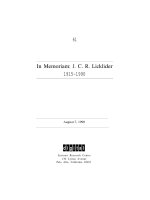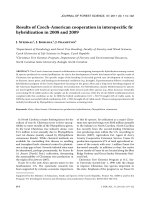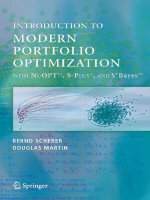(Tutorial chemistry texts) martin c r cockett, graham doggett maths for chemists numbers functions and calculus vol 1 royal society of chemistry (2003)
Bạn đang xem bản rút gọn của tài liệu. Xem và tải ngay bản đầy đủ của tài liệu tại đây (35 MB, 196 trang )
www.pdfgrip.com
www.pdfgrip.com
www.pdfgrip.com
Cover images 0 Murray Robertson/visual elements 1998-99, taken from the
109 Visual Elements Periodic Table, available at www.chemsoc.org/viselements
ISBN 0-85404-677-1
A catalogue record for this book is available from the British Library
0The Royal Society of Chemistry 2003
All rights reserved
Apart-from any fair dealing for the purposes of research or private study, or criticism or
reviews as permitted under the terms of the U K Copyright, Designs and Patents Act,
1988, this publication may not be reproduced, stored or trunsmitted, in any form or by
any means, without the prior permission in writing of The Royal Society of Chemistry, or
in the case of reprographic reproduction only in accordance with the terms of the licences
issued by the Copyright Licensing Agency in the U K , or in accordance with the terms OJ
the licences issued by the appropriate Reproduction Rights Organization outside the UK.
Enquiries concerning reproduction outside the terms stated here should be sent to The
Royal Society of Chemistry at the address printed on this page.
Published by The Royal Society of Chemistry, Thomas Graham House, Science Park,
Milton Road, Cambridge CB4 OWF, UK
Registered Charity No. 207890
For further information see our web site at www.rsc.org
Typeset in Great Britain by Alden Bookset, Northampton
Printed and bound in Italy by Rotolito Lombarda
www.pdfgrip.com
Preface
These two introductory texts provide a sound foundation in the key
mathematical topics required for degree level chemistry courses. While they
are primarily aimed at students with limited backgrounds in mathematics,
the texts should prove accessible and useful to all chemistry undergraduates.
We have chosen from the outset to place the mathematics in a chemical
context - a challenging approach because the context can often make the
problem appear more difficult than it actually is. However, it is equally
important to convince students of the relevance of mathematics in all
branches of chemistry. Our approach links the key mathematical principles
with the chemical context by introducing the basic concepts first, and then
demonstrates how they translate into a chemical setting.
Historically, physical chemistry has been the target for mathematical
support; however, in all branches of chemistry - be they the more traditional
areas of inorganic, organic and physical, or the newer areas of biochemistry,
analytical and environmental chemistry - mathematical tools are required to
build models of varying degrees of complexity, in order to develop a language
for providing insight and understanding together with, ideally, some
predictive capability.
Since the target student readership possesses a wide range of mathematical
experience, we have created a course of study in which selected key topics are
treated without going too far into the finer mathematical details. The first
two chapters of Volume 1 focus on numbers, algebra and functions in some
detail, as these topics form an important foundation for further mathematical developments in calculus, and for working with quantitative models in
chemistry. There then follow chapters on limits, differential calculus,
differentials and integral calculus. Volume 2 covers power series, complex
numbers, and the properties and applications of determinants, matrices and
vectors. We avoid discussing the statistical treatment of error analysis, in part
because of the limitations imposed by the format of this series of tutorial
texts, but also because the procedures used in the processing of experimental
results are commonly provided by departments of chemistry as part of their
programme of practical chemistry courses. However, the propagation of
errors, resulting from the use of formulae, forms part of the chapter on
differentials in Volume 1.
Martin Cockett
Graham Doggett
York
iii
www.pdfgrip.com
EDITOR-IN-CHIEF
EXECUTIVE EDITORS
EDUCATIONAL CONSULTANT
Professor E W Abel
Professor A G Davies
Professor D Phillips
Professor J D Woollins
Mr M Berry
This series of books consists of short, single-topic or modular texts, concentrating on the
fundamental areas of chemistry taught in undergraduate science courses. Each book provides a
concise account of the basic principles underlying a given subject, embodying an independentlearning philosophy and including worked examples. The one topic, one book approach ensures
that the series is adaptable to chemistry courses across a variety of institutions.
TITLES IN THE SERIES
FORTHCOMING TITLES
Stereochemistry D G Morris
Reactions and Characterization of Solids
S E Dann
Main Group Chemistry W Henderson
d- and f-Block Chemistry C J Jones
Structure and Bonding J Barrett
Functional Group Chemistry J R Hanson
Organotransition Metal Chemistry A F Hill
Heterocyclic Chemistry M Sainsbury
Atomic Structure and Periodicity J Barrett
Thermodynamics and Statistical Mechanics
J M Seddon and J D Gale
Basic Atomic and Molecular Spectroscopy
J M Hollas
Organic Synthetic Methods J R Hanson
Aromatic Chemistry J D Hepworth,
D R Waring and A4 J Waring
Quantum Mechanics for Chemists
D 0 Hayward
Peptides and Proteins S Doonan
Reaction Kinetics M Robson Wright
Natural Products: The Secondary
Metabolites J R Hanson
Maths for Chemists, Volume 1, Numbers,
Functions and Calculus M Cockett and
G Doggett
Maths for Chemists, Volume 2, Power Series,
Complex Numbers and Linear Algebra
M Cockett and G Doggett
Mechanisms in Organic Reactions
Molecular Interactions
Lanthanide and Actinide Elements
Bioinorganic Chemistry
Chemistry of Solid Surfaces
Biology for Chemists
Multi-element NMR
EPR Spectroscopy
Biophysical Chemistry
Further information about this series is available at www.rsc.orgltct
Order and enquiries should be sent to:
Sales and Customer Care, Royal Society of Chemistry, Thomas Graham House, Science Park,
Milton Road, Cambridge CB4 OWF, UK
Tel: +44 1223 432360; Fax: +44 1223 426017; Email:
www.pdfgrip.com
Contents
1.1 Real Numbers
1.2 Algebra
2
19
2.1
2.2
2.3
2.4
Defining Function
Representation of Fgnctions
Some Special Mathematical Functions
Equations
30
38
46
65
3.1 Mathematical and Chemical Examples
3.2 Defining the Limiting Process
77
81
4.1
4.2
4.3
4.4
4.5
The Average Rate of Change
The Instantaneous Rate of Change
Higher Order Derivatives
Maxima, Minima and Points of Inflection
The Differentiation of Functions of Two or
More Variables
90
91
97
102
106
V
www.pdfgrip.com
vi
Contents
5.1 The Effects of Incremental Change
5.2 The Differential of a Function of Two or More Variables
5.3 The Propagation of Errors
110
114
115
Reversing the Effects of Differentiation
The Definite Integral
The Indefinite Integral
General Strategies for Solving More
Complicated Integrals
6.5 The Connection between the Definite and
Idefinite Integral
120
121
125
6.1
6.2
6.3
6.4
7.1 Using the Derivative of a Function to
Create a Differential Equation
7.2 Some Examples of Differential Equations
Arising in Classical and Chemical Contexts
7.3 First-order Differential Equations
7.4 Second-order Differential Equations
127
132
136
137
139
150
www.pdfgrip.com
Symbols
>
3
>>
<
s
<<
/or +
#
E or z
3
E
greater than
greater than or equal to
much greater than
less than
less than or equal to
much less than
division
not equal to
approximately equal to
implies
element of
oc
=
00
proportionality
equality
infinity
summation sign
z
n product sign
!
factorial
0 braces
[ ] brackets
0 parentheses
vii
www.pdfgrip.com
www.pdfgrip.com
Numbers and Algebra
Numbers of one kind or another permeate all branches of chemistry (and
science generally), simply because any measuring device we use to record
a characteristic of a system can only yield a number as output. For
example, we might measure or determine the:
0
0
Weight of a sample.
Intensity or frequency of light absorption of a solution.
Vibration frequency for the HCl molecule.
Relative molecular mass of a carbohydrate molecule.
Or we might:
Confirm the identity of an organic species by measuring its boiling
point.
Measure, or deduce, the equilibrium constant of a reversible reaction.
Wish to count the number of isomeric hydrocarbon species with
formula C4HI0.
In some of these examples, we also need to:
0
Specify units.
Estimate the error in the measured property.
Clearly then, the manner in which we interact with the world around us
leads us quite naturally to use numbers to interpret our experiences.
In many situations, we routinely handle very large and very small
numbers, so disparate in size that it is difficult to have an intuitive feel for
order of magnitude. For example:
The number of coulombs (the basic unit of electrical charge)
associated with a single electron is approximately
0.000 000 000 000 000 000 160 2177.
The equilibrium constant for the electrochemical process
Au3+(aq)+ Al(s) e Au(s) + A13+(aq)
is of the order of 1 followed by 4343 zeros.' In chemical terms, we have no
problem with this answer, as it indicates that the equilibrium is totally
www.pdfgrip.com
2
Maths for Chemists
~
towards the right side (which means that the aluminium electrode will be
completely consumed and the gold electrode untouched).
These two widely different examples, of a type commonly experienced
in chemistry, illustrate why it is so important to feel at ease using numbers
of all types and sizes. A familiarity and confidence with numbers is of
such fundamental importance in solving quantitative chemical problems
that we devote the first two chapters of this book to underpinning these
foundations. Our main objective is to supply the necessary tools for
constructing models to help in interpreting numerical data, as well as in
achieving an understanding of the significance of such data.
1.1
Real Numbers
I.I.I Integers
One of the earliest skills we learn from childhood is the concept of
counting: at first we learn to deal with
(positive, whole
numbers), including zero, but we tend to ignore the concept of negative
numbers, because they are not generally used to count objects. However,
we soon run into difficulties when we have to subtract two numbers, as
this process sometimes yields a negative result. The concept of a negative
counting number applied to an object can lead us into all sorts of trouble,
although it does allow us to account for the notion of debt (you owe me
2 apples is the equivalent of saying “I own -2 apples”). We therefore
www.pdfgrip.com
Numbers and Algebra
extend natural numbers to a wider category of number called
which consist of all positive and negative whole numbers, as well as zero:
7
. ..,-3,-2,-1,0,1,2,3 ,...
We use integers in chemistry to specify:
0
I
The atomic number, 2, defined as the number of protons in the
nucleus; 2 is a positive integer, less than or equal to 109.
The number of atoms of a given type (positive) in the formula of a
chemical species.
The number of electrons (a positive integer) involved in a redox
reaction occurring in an electrochemical cell.
The quantum numbers required in the mathematical specification of
individual atomic orbitals. These can take positive or negative integer
values or zero, depending on the choice of orbital.
B
2
Rational Numbers
When we divide one integer by another, we sometimes obtain another
integer: For example, 6/-3 = -2; at other times, however, we obtain a
, of the form %,
where the integers a and b are
fraction, or
known as the
and
, respectively, for example, 3.
The denominator, b, cannot take the value zero because $ is of
indeterminate value.
Rational numbers occur in chemistry:
0
In defining the spin quantum number of an electron (s = 1/2), and the
nuclear spin quantum number, Z, of an atomic nucleus; for example,
45Schas Z =
In specifying the coordinates (O,O,O) and (;,;,;),
which define the
4.
0
locations of two of the nuclei that generate a body-centred unit cell of
side a.
I.IB 3 Irrational Numbers
Rational numbers can always be expressed as ratios of integers, but
sometimes we encounter numbers which cannot be written in this form.
and include:
These numbers are known as
0
0
, of the form
a,(h,which are obtained from the solution of a
quadratic or higher order equation.
, which, in contrast to surds, do not derive
from the solution to algebraic equations. Examples include n, which
3
www.pdfgrip.com
4
Maths for Chemists
we know as the ratio of the circumference to diameter of a circle, and
e, the base of natural logarithms.
I.I.4 Decimal Numbers
occur in:
Measuring chemical properties, and interpreting chemical data.
Defining relative atomic masses.
Specifying the values of fundamental constants.
Decimal numbers consist of two parts separated by a
0
Digits to the left of the decimal point give the integral part of the
number in units, tens, hundreds, thousands, etc.
A series of digits to the right of the decimal point specify the fractional
(or decimal) part of the number (tenths, hundredths, thousandths,
etc.).
We can now more easily discuss the distinction between rational and
irrational numbers, by considering how they are represented using
decimal numbers.
Rational numbers, expressed in decimal form, may have either of the
following representations:
A finite number of digits after the decimal point. For example, f
becomes 0.375.
A never-ending number of digits after the decimal point, but with a
repeating pattern. For example, $ becomes 2.121 212 . . ., with an
infinite repeat pattern of “12”.
Irrational numbers, expressed in decimal form have a never-ending
number of decimal places in which there is no repeat pattern. For
example, 7c is expressed as 3.141 592 653.. . and e as 2.718 281 82.. . As
irrational numbers like 7c and e cannot be represented exactly by a finite
number of digits, there will always be an error associated with their
decimal representation, no matter how many decimal places we include.
For example, the important irrational number e, which is the base for
natural logarithms (not to be confused with the electron charge), appears
widely in chemistry. This number is defined by the infinite sum of terms:
1 - +1- + .1. . + - + . 1. .
e = l + -1+ - +
l! 2! 3! 4!
n!
where n! is the
(pronounced “n factorial”) of the number n,
defined as n! = 1 x 2 x 3 x 4. - x n; for example, 4! = 1 x 2 x 3 x 4.
www.pdfgrip.com
Numbers and Algebra
The form of equation (1.1) indicates that the value for e keeps becoming
larger (but by increasingly smaller amounts) as we include progressively
more and more terms in the sum, a feature clearly seen in Table 1.1, where
the value for e has been truncated to 18 decimal places.
Table 1.1 An illustration of the effect of successive truncations to the
estimated value of e derived from the infinite sum of terms given in equation (1 . I )
n
Successive estimated values for e
1
5
10
15
20
25
30
2.000000000000000000
2.716666666666666666
2.718 281 801 146 384 797
2.718 281 828 458 994 464
2.718 281 828 459 045 235
2.718 281 828 459 045 235
2.718 281 828 459 045 235
Although the value of e has converged to 18 decimal places, it is still not
exact; the addition of more terms causes the calculated value to change
beyond the eighteenth decimal place. Likewise, attempts to calculate 71: are
all based on the use of formulae with an infinite number of terms:
Perhaps the most astonishing method uses only the number 2 and
surds involving sums of 2:
2
2
2
x...
71:=2x-x-
Jz d r n X d T T m
Another method involves an infinite sum of terms:
71:
1
1
-=-+2
0
1x1 1 x l x 2
lX3+1X3X5
+ 11 Xx 3l xX25 xX37 + * " ,
A particularly elegant method uses a formula that relates the square
of 71: to the sum of the inverses of the squares of all positive whole
numbers:
n2
1
1
1
1
-= l + ~ + - g + ~ + j y .
6
2
However, this requires an enormous number of terms to achieve a
satisfactory level of precision (see Chapter 1 in Volume 2 for more on
infinite series and convergence).
Working with Decimal Numbers
As we have seen above, numbers in decimal form may have a finite, or
infinite, number of digits after the decimal point. Thus, for example, we
5
www.pdfgrip.com
6
Maths for Chemists
say that the number 1.4623 has four decimal places. However, since the
decimal representations of irrational numbers, such as rc or the surd d ,
all have an infinite number of digits, it is necessary, when working with
such decimal numbers, to reduce the number of digits to those that are
(often indicated by the shorthand, “sig. figs.”). In specifying
the number of significant figures of a number displayed in decimal form,
all zeros to the left of the first non-zero digit are taken as not significant
and are therefore ignored. Thus, for example, both the numbers 0.1456
and 0.000 097 44 have four significant figures.
There are basically two approaches for reducing the number of digits to
those deemed significant:
0
0
of the decimal part of the number to an appropriate
number of
or significant digits. For example, we could
truncate n,3.141 592 653.. ., to seven significant figures (six decimal
places) by dropping all digits after the 2, to yield 3.141 592. For future
reference, we refer to the sequence of digits removed as the “tail”
which, in this example, is 653.. .
or
the decimal part of a number to a given
number of decimal places is achieved by some generally accepted
rules. The number is first truncated to the required number of decimal
places, in the manner described above; attention is then focused on
the tail (see above):
(i) If the leading digit of the tail is greater than 5 , then the last digit
of the truncated decimal number is increased by unity (rounded
up), e.g. rounding n to 6 d.p. yields 3.141 593.
(ii) If the leading digit of the tail is less than 5 , then the last digit of
the truncated decimal number is left unchanged (the number is
rounded down), e.g. rounding n to 5 d.p. yields 3.141 59.
(iii) If the leading digit of the tail is 5 , then:
If this is the only digit, or there are also trailing zeros, e.g.
3.7500, then the last digit of the truncated decimal number is
rounded up if it is odd or down if it is even. Thus 3.75 is
rounded up to 3.8 because the last digit of the truncated
number is 7 and therefore odd, but 3.45 is rounded down to
3.4 because the last digit of the truncated number is 4 and
therefore even. This somewhat complicated rule ensures that
there is no bias in rounding up or down in cases where the
leading digit of the tail is 5.
If any other non-zero digits appear in the tail, then the last
digit of the truncated decimal number is rounded up, e.g.
3.751 is rounded up to 3.8.
www.pdfgrip.com
Numbers and Algebra
Observations on Rounding
Worked Problem 1.1 illustrates that different answers may be produced if
the rules are not applied in the accepted way. In particular, sequential
rounding is not acceptable, as potential errors may be introduced because
more than one rounding is carried out. In general, it is accepted practice
to present the result of a chemical calculation by rounding the result to
the number of significant figures that are known to be reliable (zeros to
the left of the first non-zero digit are not included). Thus, although n is
given as 3.142 to four significant figures (three decimal places), n/1000 is
given to four significant figures (and six decimal places) as 0.003142.
Rounding Errors
It should always be borne in mind that, in rounding a number up or
down, we are introducing an error: the number thus represented is merely
an approximation of the actual number. The conventions discussed
above, for truncating and rounding a number, imply that a number
obtained by rounding actually represents a range of numbers spanned by
the implied error bound. Thus, n expressed to 4 decimal places, 3.1416,
represents all numbers between 3.14155 and 3.14165, a feature that we
can indicate by writing this rounded form of n as 3.14160 & 0.00005.
Whenever we use rounded numbers, it is prudent to aim to minimize the
rounding error by expressing the number to a sufficient number of
decimal places. However, we must also be aware that if we subsequently
7
www.pdfgrip.com
8
Maths for Chemists
combine our number with other rounded numbers through addition,
subtraction, multiplication or division, the errors associated with each
number also combine, propagate and generally grow in size through the
calculation.
I.I.5 Combining Numbers
Numbers may be combined using the
of addition
(+), subtraction (-), multiplication ( x ) and division (/ or +). The type
of number (integer, rational, irrational) is not necessarily maintained
under combination. Thus, for example, addition of the fractions 1/4 and
3/4 yields an integer, but division of 3 by 4 (both integers) yields the
rational number (fraction) 3/4. When a number (say, 8) is multiplied by a
fraction (say, 3/4), we say in words that we want the number which is
three quarters of 8 which, in this case, is 6.
For addition and multiplication the order of operation is unimportant,
regardless of the number of numbers being combined. Thus:
2+3=3+2
and
2x3 =3x2
www.pdfgrip.com
Numbers and Algebra
and we say both addition and multiplication are
. However,
for subtraction and division, the order of operation is important, and we
say that both are
2-323-2
and
2
3
7%
One consequence of combining operations in an arithmetic expression is
that ambiguity may arise in expressing the outcome. In such cases, it is
imperative to include brackets (the generic term), where appropriate, to
indicate which arithmetic operations should be evaluated first. The order
in which arithmetic operations may be combined is described, by
convention, by the
rules of precedence. These state that the
order of preference is as follows:
Brackets
Of (multiplication by a fraction)
Division
Multiplication
Addition/Subtraction
For example:
0
If we wish to evaluate 2 x 3 + 5, the result depends upon whether
we perform the addition prior to multiplication or vice versa. The
BODMAS rules tell us that multiplication takes precedence over
addition and so the result should be 6 + 5 = 11 and not 2 x 8 = 16.
Using parentheses in this case removes any ambiguity, as we would
then write the expression as (2 x 3) 5.
If we wish to divide the sum of 15 and 21 by 3, then the expression
15 + 21/3 yields the unintended result 15 + 7 = 22, instead of 12, as
division takes precedence over addition. Thus, in order to obtain the
intended result, we introduce parentheses ( ) to ensure that
summation of 15 and 21 takes place before division:
+
(15 + 21)/3 = 36/3 = 12
Alternatively, this ambiguity is avoided by expressing the quotient in
the form:
15 + 12
3
sign, /, for division is in widespread use, it is
However, as the
important to be aware of possible ambiguity.
9
www.pdfgrip.com
10
Maths for Chemists
Powers or Indices
When a number is repeatedly multiplied by itself in an arithmetic
expression, such as 3 x 3 x 3, or x f x $ x the
or
notation
) is used to write such products in the forms
(also often called the
33 and 2 , respectively. Both numbers are in the general form a n , where
(2),
n is the index. If the index, 12, is a positive integer, we define the number a
as a raised to the nth power.
We can define a number of laws for combining numbers written in this
form simply by inspecting expressions such as those given above: For
example, we can rewrite the expression:
i,
as
3 3 3 3
-x-x-x-=
2 2 2 2
(!)2 3(23) 1
=
(i)
4
and we see that the result is obtained simply by adding the indices of the
numbers being combined. This rule is expressed in a general form as:
For rational numbers, of the form i , raised to a power n, we can rewrite
the number as a product of the numerator with a positive index and the
denominator with a negative index:
( I .3)
which, in the case of the above example, yields:
On the other hand, if b
the rule gives:
=
a, and their respective powers are different, then
The same rules apply for rational indices, as is seen in the following
example:
();
3'2
=@
33'2= 3
312
x 2-312
www.pdfgrip.com
Numbers and Algebra
Rational Powers
i, 4,
Numbers raised to powers
f, . . . define the square root, cube
root, fourth root, .. . , nth root, respectively. Numbers raised to the
power m/n are interpreted either as the rnth power of the nth root or as
the nth root of the rnth power. For example, 3 m J " = ( 3 1 ' " ) ~ = ( 3 ~ ) 1 J " .
Numbers raised to a rational power may either simplify to an integer,
for example (27)lJ3= 3, or may yield an irrational number, for example
(27)lJ2= 3 x 31J2= 33J2.
Further Properties of Indices
Consider the simplification of the expression (32 x 103)2:
The above example illustrates the further property of indices that
(a")" = anxm.Thus, we can summarize the rules for handling indices in
equation (1.5):
Note that, when multiplying symbols representing numbers, the
multiplication sign ( x ) may be dropped. For example, in the
penultimate expression in equation (1 S), a"
becomes anm. In these
kinds of expression, n and m can be integer or rational. Finally, if the
product of two different numbers is raised to the power n, then the result
is given by:
Worked Problem 1.2 and Problem 1.4 further illustrate how the
(BODMAS) rules of precedence operate.
11
www.pdfgrip.com
12
Maths for Chemists
I.I.6 Scientific Notation
As has been noted earlier, many numbers occurring in chemical
calculations are either extremely small or extremely large. Clearly, it
becomes increasingly inconvenient to express such numbers using
becomes increasingly large
decimal notation, as the
or small. For example, as seen in the introduction, the charge on an
electron (in coulombs), expressed as a decimal number, is given by:
0.000 000 000 000 000 000 1602 177
www.pdfgrip.com
Numbers and Algebra
13
To get around this problem we can use
to write such
numbers as a signed decimal number, usually with magnitude greater than
or equal to 1 and less than 10, multiplied by an appropriate power of 10.
Thus, we write the fundamental unit of charge to nine significant
figures as 1.602 177 33 x lo-'' C.
Likewise, for very large numbers, like the speed of light, we write c
= 299 792 458 m s-l, which, in scientific notation, becomes 2.997 924 58 x
lo8 m s-l(9 sig. figs.). Often we use c = 3 x lo8 m s-I, using only one sig.
fig., if we are carrying out a rough calculation.
Sometimes, an alternative notation is used for expressing a number in
scientific form. Instead of specifying a power of 10 explicitly, it is common
practice (particularly in computer programming) to give expressions for
the speed of light and the charge on the electron as 2.998e8 m s-l and
1.6e-19 C, respectively. In this notation, the number after the e is the
power of 10 multiplying the decimal number prefix.
Combining Numbers Given in Scientific Form
and 3.5 x
Consider the two numbers 4.2 x
quotient are given respectively by:
4.2 x lo-' x 3.5 x
their product and
14.7 x
1.47 x
and
However, in order to calculate the sum of the two numbers (by hand!), it
may be necessary to adjust one of the powers of ten, to ensure equality of
powers of 10 in the two numbers. Thus, for example:
+ 3.5 x
4.2 x
= 0.042 x loa6
+ 3.5 x
= 3.542 x
Names and Abbreviations for Powers of Ten
As we have seen in some of the examples described above, an added
complication in performing chemical calculations often involves the
presence of units. More often than not, these numbers may be expressed
in scientific form, and so, in order to rationalize and simplify their
specification, it is conventional to use the names and abbreviations given
in Table 1.2, adjusting the decimal number given as prefix as appropriate.
~~
~~~
~
~
Table 1.2 Names and abbreviations used to specify the order of magnitude of numbers expressed in scientific notation
1015
ioI2
lo9
lo6
103
10-1
10-2
10-3
10-6
10-9
10-12
10-15
10-18
peta
P
tera
T
giga
G
mega
M
kilo
k
deci
d
centi
milli
m
micro
P
nano
n
pic0
P
femto
f
atto
a
C
www.pdfgrip.com
14
Maths for Chemists
Thus, for example:
The charge on the electron is given as 0.16 aC, to two significant
figures.
The binding energy of the electron in the hydrogen atom is given by
2 . 1 7 9 ~lo-'* J, which is specified as 2.179 aJ.
The bond vibration frequency for HF is 1.2404 x 1014 s-l, which is
given as 124.04 Ts-' or 0.124 04 Ps-'.
Some of these data are used in Problem 1.5.
The results you obtain for Problem 1.5 should show that, since the
joule (J) is a macroscopic base unit of energy, property values on the
microscopic scale have extremely small magnitudes. We now explore this
idea further in Worked Problem 1.3 and in Problem 1.6 to give more
practice in manipulating numbers in scientific form and, more importantly, to provide further insight into size differences in the microscopic
and macroscopic worlds.
www.pdfgrip.com
Numbers and Algebra
15









